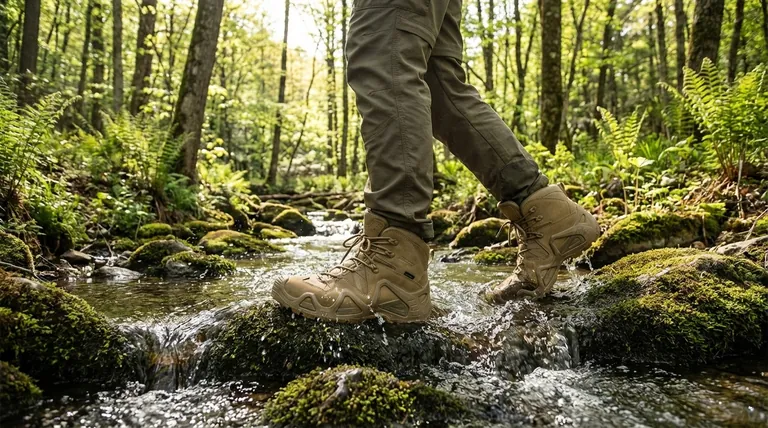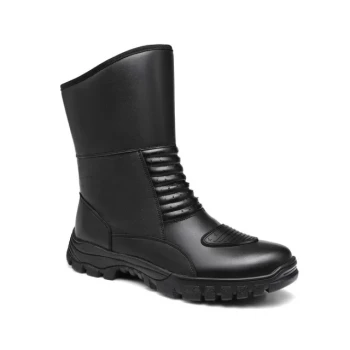Yes, but with a critical understanding of their design. Jungle boots can be effectively used in temperate climates, particularly during warmer and wetter seasons like spring and summer. Their core strengths—durability, breathability, and rapid water drainage—translate well to these conditions. However, the very features that make them ideal for the jungle render them unsuitable and even dangerous in the cold.
A jungle boot is engineered to let water out, not to keep it from getting in. This makes it a superior tool for hot, wet environments where feet will inevitably get soaked, but a significant liability in cold weather where staying dry is essential for safety.

The Core Design Philosophy of a Jungle Boot
To understand where this boot fits, you must first understand its purpose. It was not designed to be a general-purpose boot; it was engineered to solve the specific problems of jungle warfare.
Built for Drainage, Not Waterproofing
The most defining feature of a jungle boot is its drainage system. These boots often have small metal eyelets near the instep designed to actively pump water out as you walk.
The core assumption is that your feet will get completely submerged. The priority is not to prevent this, but to get the water out as quickly as possible to prevent debilitating conditions like trench foot in a hot, humid climate.
Prioritizing Breathability
Jungle boots typically combine a sturdy leather lower with lightweight canvas or nylon uppers. This construction is not waterproof but is highly breathable.
This allows air to circulate, helping your feet and socks dry much faster through evaporation once you are out of the water. In hot weather, this prevents the "swamp foot" that occurs in non-breathable waterproof boots.
Understanding the Trade-offs in a Temperate Climate
The specialized design of a jungle boot creates significant trade-offs when moved outside of its intended environment.
The Problem with Cold and Wet Conditions
The drainage vents that are a benefit in the heat become a major hazard in the cold. When crossing a cold stream or walking in a chilly rain, those vents become entry points for cold water.
This will instantly saturate your socks and rapidly pull heat from your feet, dramatically increasing the risk of discomfort and non-freezing cold injuries.
A Complete Lack of Insulation
Jungle boots contain virtually no insulation. They are designed to shed heat, not retain it.
Using them in temperate autumn or winter conditions will leave your feet extremely vulnerable to the cold, even in dry weather. They simply cannot provide the thermal protection needed when temperatures drop.
When Jungle Boots Excel in Temperate Zones
Despite the drawbacks, there are specific scenarios where a jungle boot is an excellent choice for temperate use.
Hot and Wet Summers
For activities like hiking through frequent stream crossings, kayaking, or working in muddy, warm conditions, the jungle boot performs exceptionally well. It allows you to move through water without concern, draining and drying quickly afterward.
Dry and Warm Conditions
In dry spring and summer weather, a jungle boot can serve as a durable and highly breathable hiking or work boot. It will often be more comfortable than a heavy, waterproof boot that can cause your feet to sweat excessively.
How to Apply This to Your Goal
Your decision should be based entirely on the expected temperature and conditions of your activity.
- If your primary focus is activity in warm, wet summer conditions: Jungle boots are an excellent choice, as they will drain quickly and keep your feet from overheating.
- If your primary focus is general use in dry spring and summer: Their durability and breathability make them a viable and comfortable option over heavier waterproof boots.
- If your primary focus is activity in any cold or cool, wet conditions: You must avoid jungle boots; their design is fundamentally unsuited for keeping feet warm and dry.
Choosing the right footwear is about matching the tool's intended purpose to your specific need.
Summary Table:
| Climate Condition | Jungle Boot Suitability | Key Reason |
|---|---|---|
| Warm, Wet Summers (e.g., hiking, stream crossings) | Excellent | Superior drainage and breathability prevent overheating and wet feet. |
| Dry, Warm Summers | Good | Highly breathable and durable for general hiking or work. |
| Cool/Cold, Wet Conditions (e.g., autumn, winter) | Poor / Hazardous | Drainage vents let cold water in; lack of insulation risks cold injuries. |
Need the Right Boot for Your Climate and Market?
As a large-scale manufacturer, 3515 produces a comprehensive range of durable footwear for distributors, brand owners, and bulk clients. Whether you need specialized boots for warm, wet conditions or insulated boots for colder climates, our production capabilities encompass all types of shoes and boots to meet your specific market demands.
Contact our experts today to discuss your footwear needs and discover how we can deliver quality and value to your business.
Visual Guide

Related Products
- Wholesale Waterproof Tactical Boots Custom Suede & High-Traction Soles
- Wholesale Tactical Boots High-Traction & Reflective for Bulk & Brand Orders
- Durable Military Combat Boots with Water Drainage for Wholesale & OEM
- Factory-Direct Wholesale Canvas Boots with High-Traction Rubber Soles
- Durable High-Ankle Tactical Boots Wholesale Manufacturer for Custom & Bulk Orders
People Also Ask
- How do uniform requirements influence the choice between tactical boots and sneakers? Select Compliant Footwear for Your Role
- Why is waterproofing important for tactical boots? Protect Your Feet and Gear in Any Mission
- How do military camouflage boots protect against adverse weather? Ensuring Dry, Warm Feet in Any Condition
- Why is waterproofing important in tactical boots? Essential for Foot Health & Mission Success
- What are some real-world applications of military camouflage boots? From Tactical to Trendsetting



















